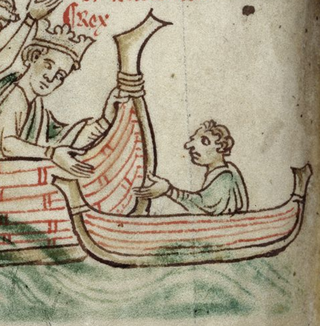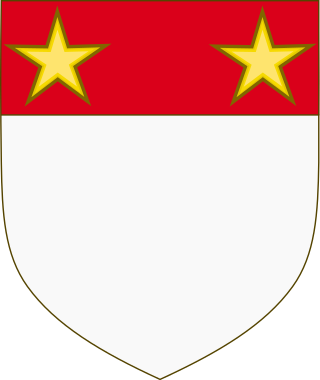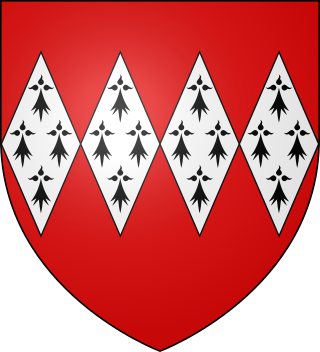
Baron Hastings is a title that has been created three times. The first creation was in the Peerage of England in 1290, and is extant. The second creation was in the Peerage of England in 1299, and became extinct on the death of the first holder in c. 1314. The third creation was in the Peerage of England in 1461, and has been in abeyance since 1960.

Baron Strange is a title which has been created four times in the Peerage of England. Two creations, one in 1295 and another in 1326, had only one holder each, upon whose deaths they became extinct. Two of the creations, that of 1299 and that of 1628, are extant. The surname Le Strange was Latinized as Extraneus. The arms of Le Strange of Knockin Castle in Shropshire were: Gules, two lions passant argent.

Baron le Despencer is a title that has been created several times by writ in the Peerage of England.
Baron Lisle was a title which was created five times in the Peerage of England during the Middle Ages and Tudor period, and once in the Peerage of Ireland in the 18th century.

Nicholas de Moels or Nicholas Molis was an Anglo‑Norman royal administrator and household knight of King Henry III of England. In this capacity he was assigned many and varied offices and duties, often of a temporary nature. He married a wealthy heiress from North Cadbury in Somerset which transformed him into a major landholder and feudal baron. In 1244 whilst serving as Seneschal of Gascony, he inflicted a defeat on the King of Navarre, whom he took prisoner in the field.

The titles Baron Montacute or Baron Montagu were created several times in the Peerage of England for members of the House of Montagu. The family name was Latinised to de Monte Acuto, meaning "from the sharp mountain"; the French form is an ancient spelling of mont aigu, with identical meaning.

Baron St John of Basing is a former title in the Peerage of England. The family of St John of Basing in Hampshire and of Halnaker in Sussex was descended in the male line from the Norman Hugh de Port (d.1091) lord of the manor of Port-en-Bessin in Normandy who took part in the Norman Conquest of England in 1066, and was subsequently granted 53 manors in Hampshire. They had adopted the St. John surname by 1205.)

North Cadbury is a village and civil parish 5 miles (8 km) west of Wincanton, by the River Cam, in the Unitary Authority of Somerset, England. It shares its parish council with nearby Yarlington and its civil parish includes the village of Galhampton, which got its name from the settlement of the rent-paying peasants, and the hamlet of Woolston.

Hugh de Courtenay, 1st/9th Earl of Devon of Tiverton Castle, Okehampton Castle, Plympton Castle and Colcombe Castle, all in Devon, feudal baron of Okehampton and feudal baron of Plympton, was an English nobleman. In 1335, forty-one years after the death of his second cousin once-removed Isabel de Redvers, suo jure 8th Countess of Devon he was officially declared Earl of Devon, although whether as a new creation or in succession to her is unknown, thus alternative ordinal numbers exist for this Courtenay earldom.
The Courtenay barony was created in 1299, when Hugh de Courtenay was summoned to Parliament, thus becoming the first Baron Courtenay. He was subsequently made Earl of Devon in 1335. During his life, his son Hugh de Courtenay the younger, was summoned as 2nd Baron Courtenay in 1337, with the barony coming to represent a courtesy title for the heir of the Earls of Devon. This Hugh succeeded as Earl on his father's death in 1340, and since his own son, also Hugh, died in 1348 without having been summoned as baron, it was Earl Hugh's grandson, yet another Hugh, who was summoned as 3rd Baron Courtenay in 1371, during his grandfather's life. He died three years later, and on the Earl's 1377 death, both the Earldom of Devon and the Barony of Courtenay passed to another grandson, Edward de Courtenay, first cousin of the previous courtesy holder of the barony. Though his son Edward would be styled 'Lord Courtenay' during his father's lifetime, he was never summoned under the courtesy title and he predeceased his father, so the earldom and barony devolved on the Earl's younger son, Hugh de Courtenay, 4th/12th Earl of Devon and 5th Baron Courtenay. Both titles then passed together for two generations, but in 1461, Thomas Courtenay, 6th/14th Earl of Devon and 7th Baron, was attainted and executed, and the barony forfeited.
Sir Hugh de Courtenay (1251–1292) was the son and heir of John de Courtenay, feudal baron of Okehampton, Devon, by Isabel de Vere, daughter of Hugh de Vere, 4th Earl of Oxford. His son inherited the earldom of Devon.

Sir William Russell (1257–1311) was an English nobleman, knight, and holder of a moiety of the feudal barony of North Cadbury, Somerset, but spent most of his life engaged in the administration and defence of the Isle of Wight, where he obtained by marriage the manor of Yaverland. He served as constable of Carisbrooke Castle, and sat in parliament on two occasions, firstly as burgess for Great Bedwyn, Wiltshire, and then for the County of Southampton. As a baron his military service was called on several times by King Edward I Hammer of the Scots.

William de Botreaux (1337–1391) was a prominent British West-Country baron during the reigns of King Edward III (1327-1377) and King Richard II (1377-1399).

William de Botreaux, 3rd Baron Botreaux (1389–1462) was a baron, whose holdings were in Somerset and the south-west of England. He inherited from his father the barony by writ of Botreaux as well as substantial family landholdings which included a moiety of the feudal barony of North Cadbury, Somerset, in the parish church of which capital manor he was buried, as he requested in his will.
The Manor of Dyrham was a former manorial estate in the parish of Dyrham in South Gloucestershire, England.

The Manor of Molland was a medieval manor in North Devon, England. It was largely co-terminous with the existing parish of Molland, in which is situated the village of Molland. More accurately it consisted from the earliest times of two separate manors, held from separate overlords, later known as Molland-Bottreaux and Molland-Champson.

Sir John Dinham (1359–1428) was a knight from Devonshire, England. His principal seats were at Hartland in North Devon, Kingskerswell and Nutwell in South Devon, Buckland Dinham in Somerset and Cardinham in Cornwall. He killed one of the murderers of his father in Exeter Cathedral, for which he was pardoned by the king. He later broke into Hartland Abbey and assaulted the Abbot over a long-standing disagreement, and also performed other acts of violence. He married three times; his heir was John Dinham (1406–1458). His monument survives in Kingskerswell parish church.
The feudal barony of Curry Mallet was an English feudal barony with its caput at Curry Mallet Castle in Somerset, about 7 miles east of Taunton.

Sir Thomas Courtenay of Wootton Courtenay in Somerset, was a knight and an English military commander against the French during the Hundred Years' War, who died about six years after the Battle of Poitiers.

John de Moels, 1st Baron Moels, feudal baron of North Cadbury in Somerset, was an English peer.













